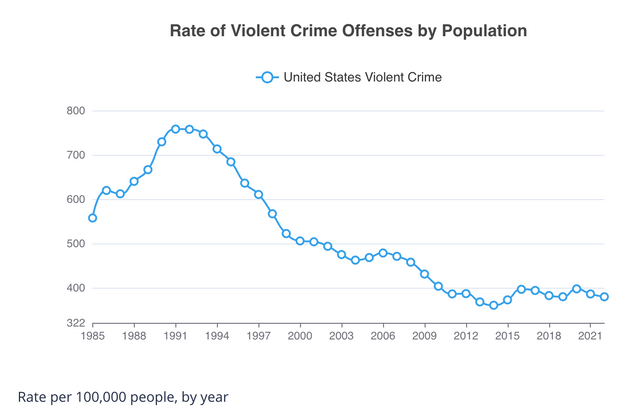How Safe Is Our World Today, Really?
I have noticed increased vigilance amongst the population, increased reporting of crimes and headlines in newspapers, increased interest in true crime, crime documentaries/films, and a general public intoxication of crime. Why people have become so enamored with genres such as true crime, I don’t think is necessarily a modern phenomenon — I mean, take a look at the sheer popularity of Agatha Christie’s books, with her first book being published in 1920 (Britannica, 2024).
If we take a look at data from the FBI’s Crime Data Explorer (https://cde.ucr.cjis.gov/LATEST/webapp/#/pages/explorer/crime/crime-trend), we can see some really interesting things. For example, if we look at the rate of violent crime offenses by population (in the U.S.), we are met with data that suggests that 2022 is one of the “safest” years.

Despite these reassuring statistics, according to the Lloyd’s Register Foundation World Risk Poll (2021), 39% of Americans surveyed feel less safe than they did five years ago. As well as that, 26% of Americans felt very worried about violent crime causing them serious harm, which was an increase from 22% in 2019. So, despite there being evidence from the FBI that 2021 and 2022 are significantly safer than other years, in regards to violent crime, individuals feel less safe compared to 5 years ago (2016), which was more unsafe than 2021. In 2016, the FBI reported there to have been a rate of 397.5 violent crime offenses per 100,000 compared to 387 in 2021.
So, even though the world is safer than it previously was, people still are more concerned about their safety. This feeling of unsafety could be a result of the COVID-19 pandemic, which, for many individuals, led to long-term health consequences or mental health consequences. However, this perception gap (Ropeik, 2011) between the likelihood of violent crime and the perceived fear of violent crime existed long before the pandemic. Many individuals chalk this perception gap up to the media, the increased reporting of violent crimes, and the idea of “if it bleeds, it leads” – a term coined by William Randolph Hearst at the end of the 1890s.
Surveys such as the Figgie Report on Fear of Crime (Research and Forecasts Inc, 1980) suggest that the fear of crime was also pervasive in the late 70s/80s, with 4 out of 10 Americans being highly fearful of becoming victims of violent crime. However, as we can see from the FBI UCR data above, the 80s into the mid-90s was a time where the rate of violent crime offenses were significantly higher, meaning perhaps Americans’ fear at the time was more based in true likelihood rather than perceived likelihood.
If we consider comparing violent crime to another type of crime, such as property crimes, we are met with starkly higher rates of offenses than that of violent crimes. All property crimes include arson, burglary, larceny-theft, and motor vehicle theft, and all violent crimes include homicide, rape, robbery, and aggravated assault. In 2022, the rate of property crime offenses was 1,954.4 per 100,000 people, compared to 380.7 per 100,000 people for violent crimes. Despite more offenses of property crime occurring per year in the United States, it is given less media attention. In Michael O’Hear’s statistical overview of media coverage in Milwaukee, Wisconsin (2020), he compared the offenses noted on the front page of the Journal Sentinel and WTMJ.com to offenses reported to police in Wisconsin.
[Will try to re-insert media; had issues trying to attach the pie charts]
Theft and burglary accounted for 62% of the crimes reported in Milwaukee County and 68% statewide. This starkly contrasts the reporting of these two crimes, accounting only for 3% of the Journal Sentinel stories and 22% of the stories reported on WTMJ.com. O’Hear also made an interesting realization that the media placed a stronger emphasis on crime with female victims and young victims, which, according to the data relating to homicide victims in Milwaukee, was disproportionate to the actual patterns.
Works Cited
Britannica, T. Editors of Encyclopaedia (2024, February 16). Agatha Christie. Encyclopedia Britannica. https://www.britannica.com/biography/Agatha-Christie
FBI Crime Data Explorer, UCR https://cde.ucr.cjis.gov/LATEST/webapp/#/pages/explorer/crime/crime-trend
Lloyd’s Register Foundation. (2021). World Risk Poll, Gallup Data. Retrieved from https://wrp.lrfoundation.org.uk/a-world-of-risk-country-overviews-2021/
Ropeik, D. (2011, February 3). The perception gap: An explanation for why people maintain irrational fears. Scientific American Blog Network. https://blogs.scientificamerican.com/guest-blog/the-perception-gap-an-explanation-for-why-people-maintain-irrational-fears/
Research and Forecasts Inc. (1980) Figgie Report on Fear of Crime – America Afraid, Part One – The General Public. https://www.ojp.gov/ncjrs/virtual-library/abstracts/figgie-report-fear-crime-america-afraid-part-one-general-public
Michael O’Hear, Violent Crime And Media Coverage In One City: A Statistical Snapshot, 103 Marq. L. Rev. 1007 (2020).
Available at: https://scholarship.law.marquette.edu/mulr/vol103/iss3/14